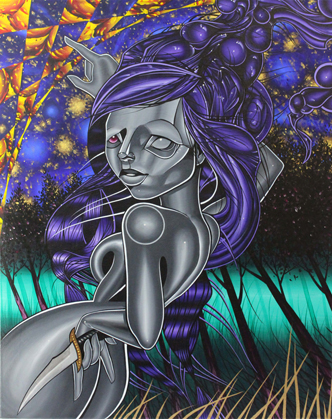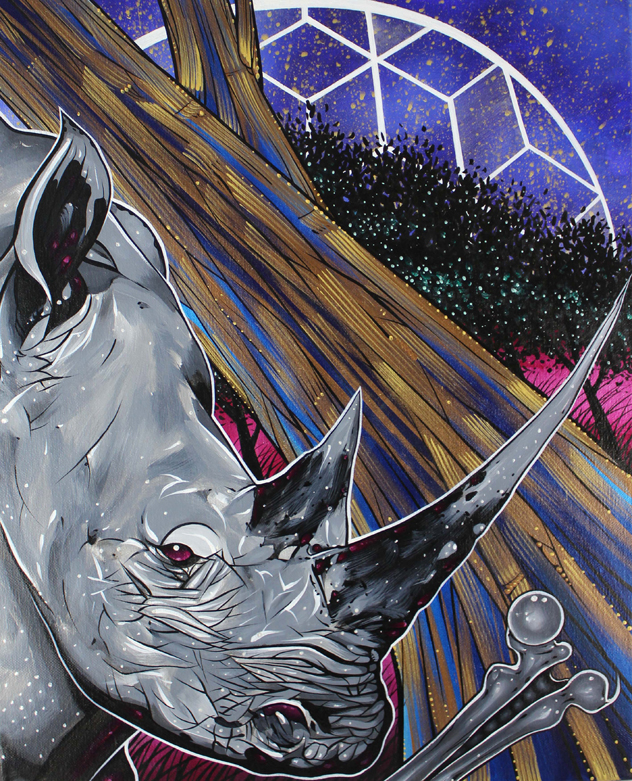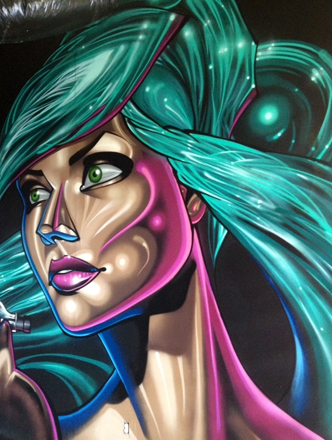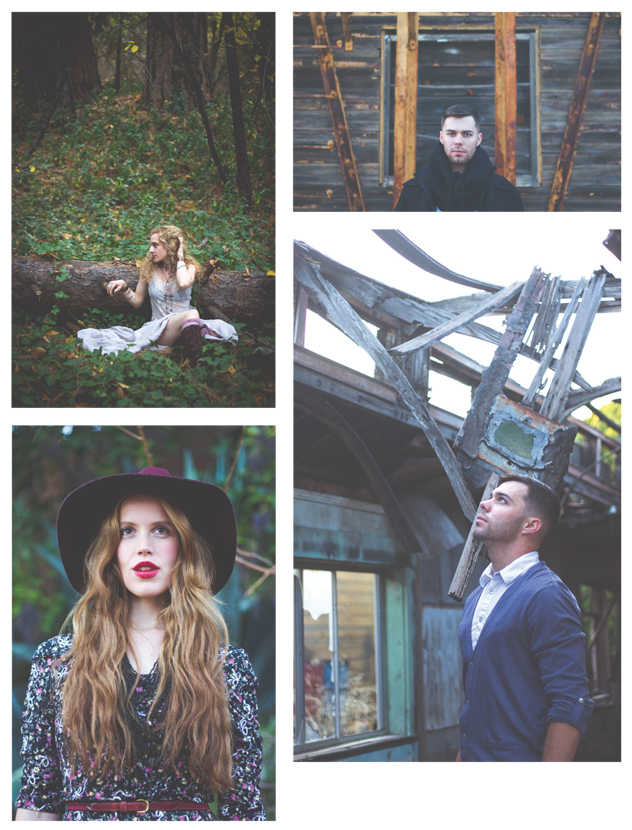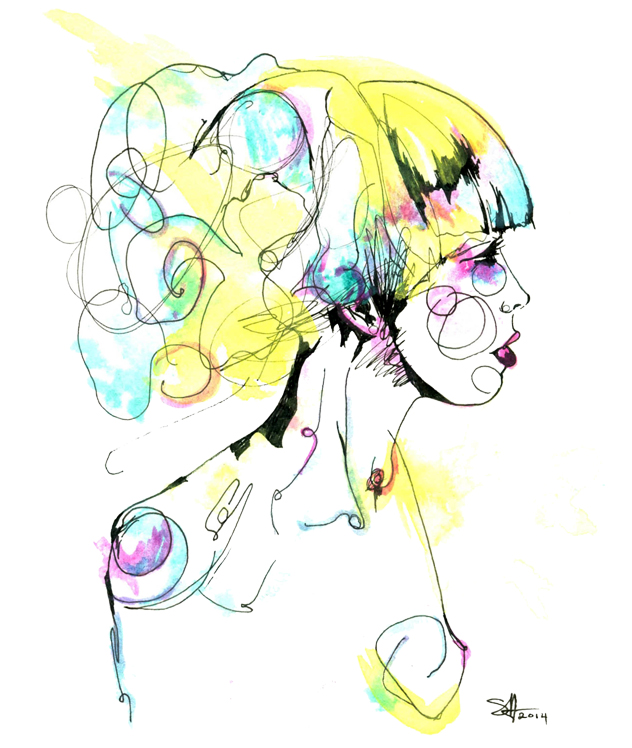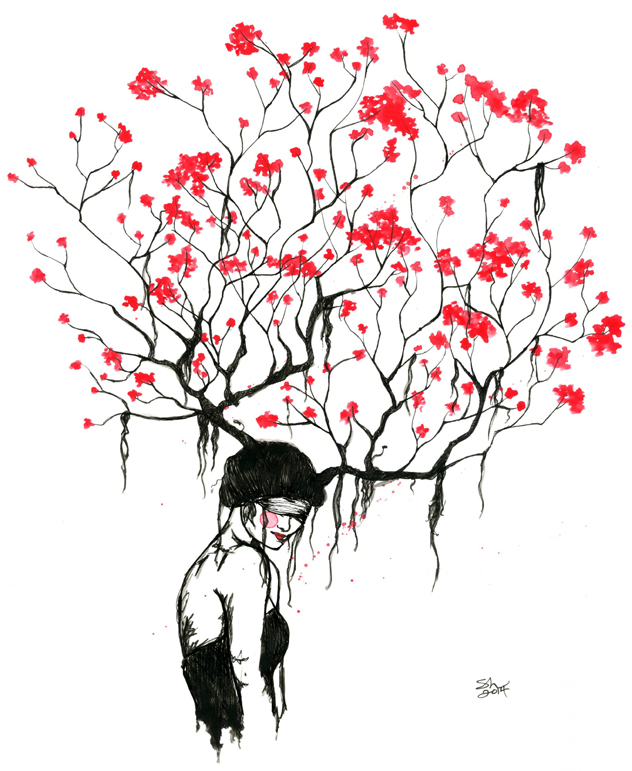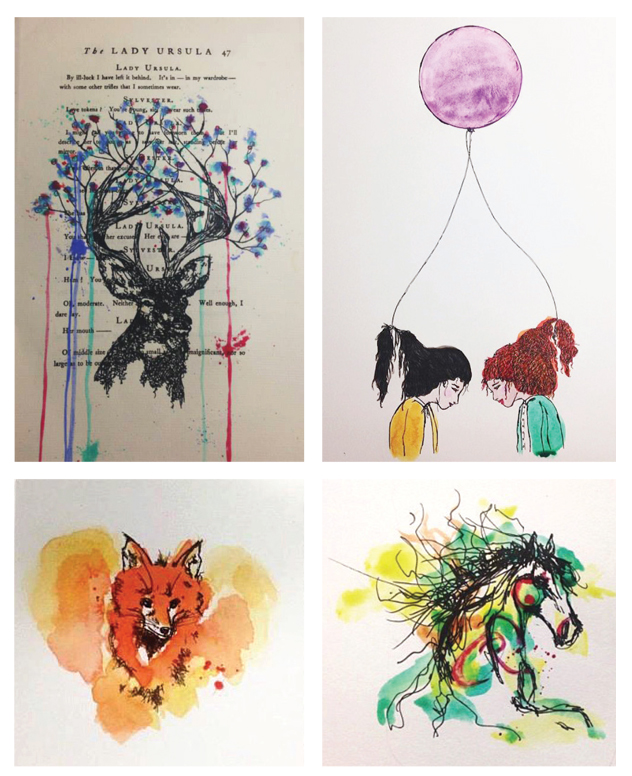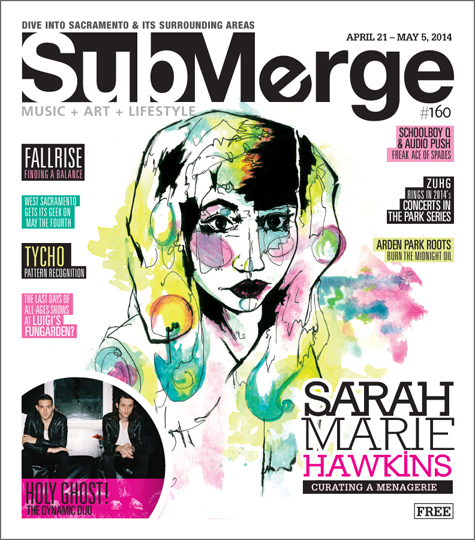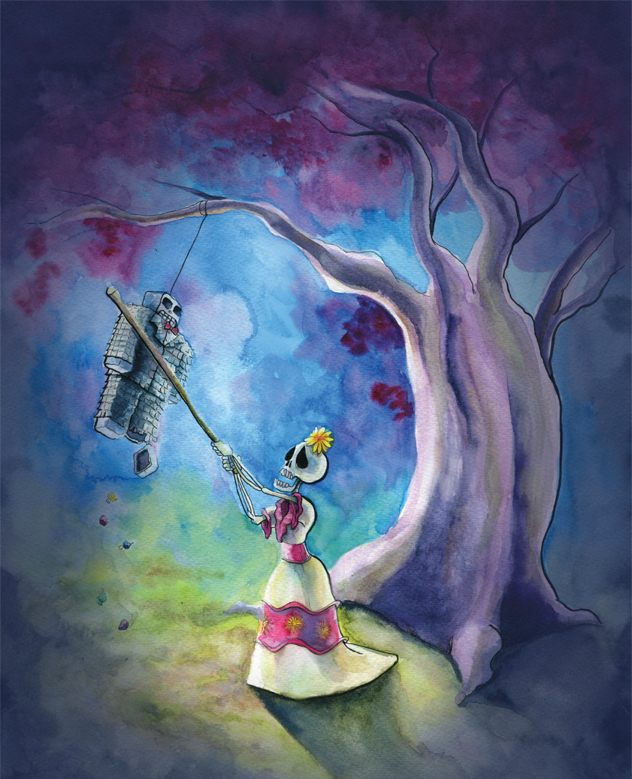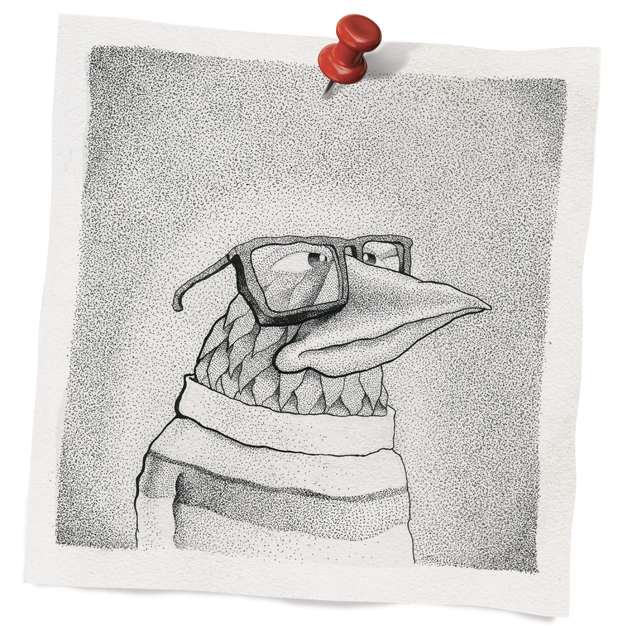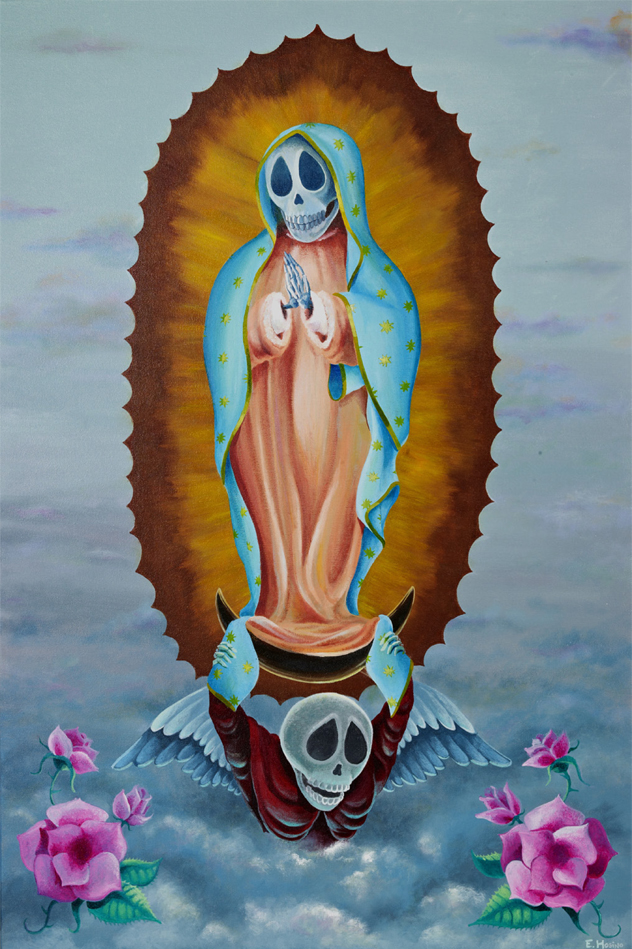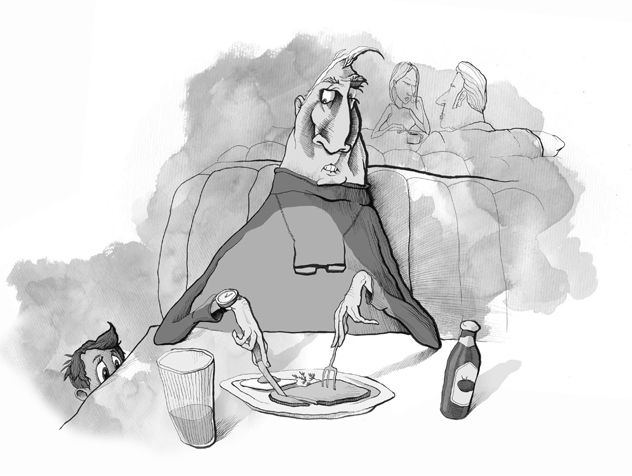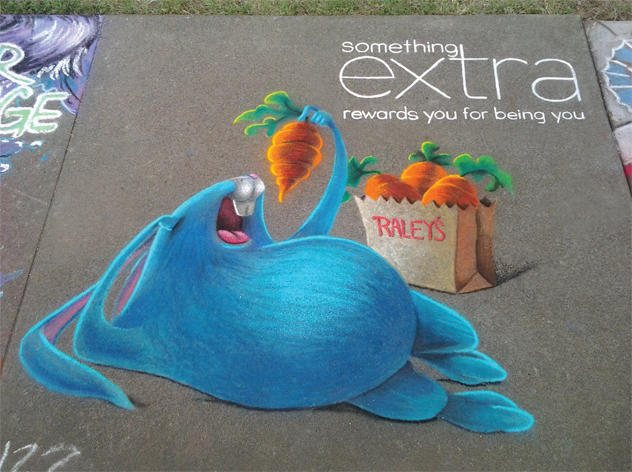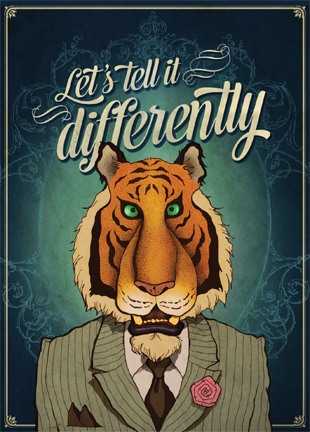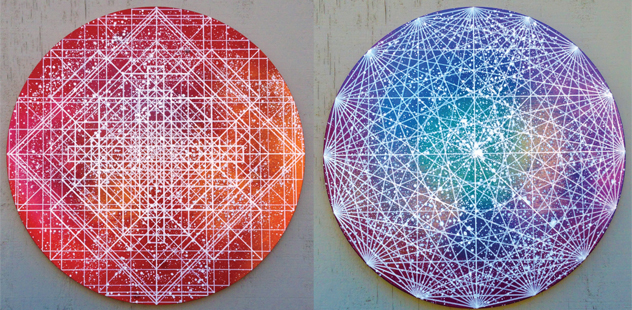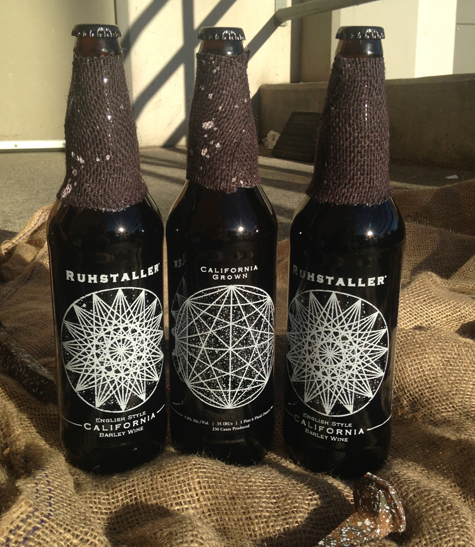It’s safe to say that with her fourth full-length album, Abyss, set to be released August 7, 2015, on Sargent House, ex-Sacramentan Chelsea Wolfe has reached a whole new level in her already impressive career. Having always been known for her dark, hypnotizing sound and aesthetic, Abyss is easily Wolfe’s heaviest and most personal album to date. According to a statement by Wolfe, “Abyss is meant to have the feeling of when you’re dreaming, and you briefly wake up, but then fall back asleep into the same dream, diving quickly into your own subconscious”. The last couple of years have been crazy for Wolfe. She’s toured with Queens of the Stone Age, landed on the covers of magazines all over the world, and has even had songs featured in trailers for the popular HBO show Game of Thrones as well as the upcoming feature film Dark Places, which is based on the book by the best-selling author of Gone Girl. On Abyss, Wolfe continued her ongoing collaboration with co-writer and multi-instrumentalist Ben Chisholm and drummer Dylan Fujioka. Ezra Buchla was brought on board to play viola and Mike Sullivan of the band Russian Circles contributed his guitar wizardry. The group recorded in Dallas, Texas with producer/engineer John Congleton (Swans, St. Vincent). The first single off the album “Iron Moon” was recently debuted on Rolling Stone’s website, and the second single “Carrion Flowers” was debuted by NPR’s All Songs Considered, so to say Wolfe is already receiving good press would be an understatement. Abyss is available for pre-order now. Visit Chelseawolfe.net for more details. A tour in support of the new album has also been announced and the closest she’ll get to Sacramento is on Saturday, Sept. 26, 2015, when Wolfe and her band will play at San Francisco’s The Regency Ballroom.
Tag Archives: Sacramento artist
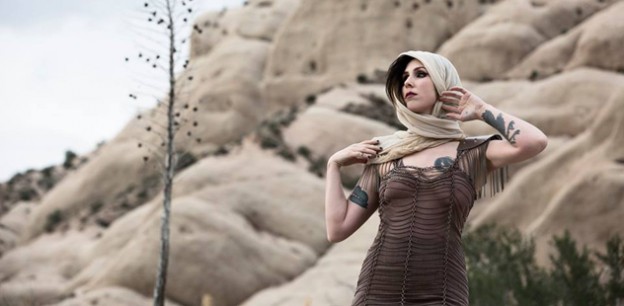
Chelsea Wolfe Set to Release Haunting New Album Abyss on August 7
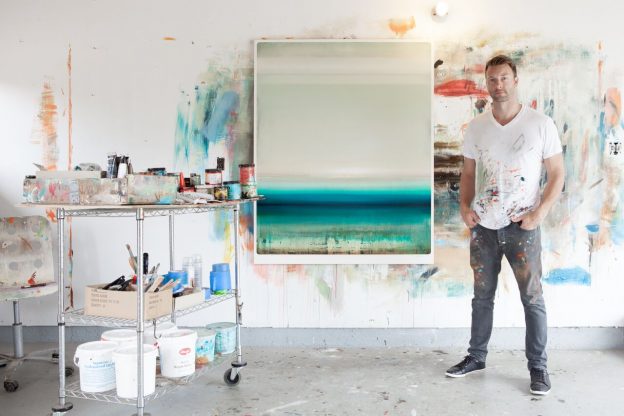
Blurred Lines • Abstract artist Micah Crandall-Bear shows a subtler side in his new exhibition
Micah Crandall-Bear’s latest body of work is a lot like the artist himself—a combination of precision and a minimalistic sensibility that draws heavily from a deep appreciation of natural beauty.
For those unfamiliar with Crandall-Bear’s artistic vision, the painter operates in the world of the abstract. His canvases are heavily layered acrylic landscapes of bold striations of colors focused on hard line compositions that explore the many nuances of something we see every day: the horizon. His technique is methodical and precise, implementing a traditional method that is typically associated with oil painting wherein swiftness is essential. Layers of wet paint are applied to previous layers of wet paint in linear brushstrokes that traverse the entire length of the canvas from left to right.
His latest body of work, titled Latitudes and is currently on display at Elliott Fouts Gallery through July 2, eschews cityscapes, but instead celebrates the refinement of nature.
“This show, instead of trying to be complex … is actually a bit more subtle,” Crandall-Bear explains. “It’s also more refined. There used to be a lot of exaggerated line and color, where in these paintings it’s got a little bit more of a desaturated feel. So it’s softer, more subtle.”
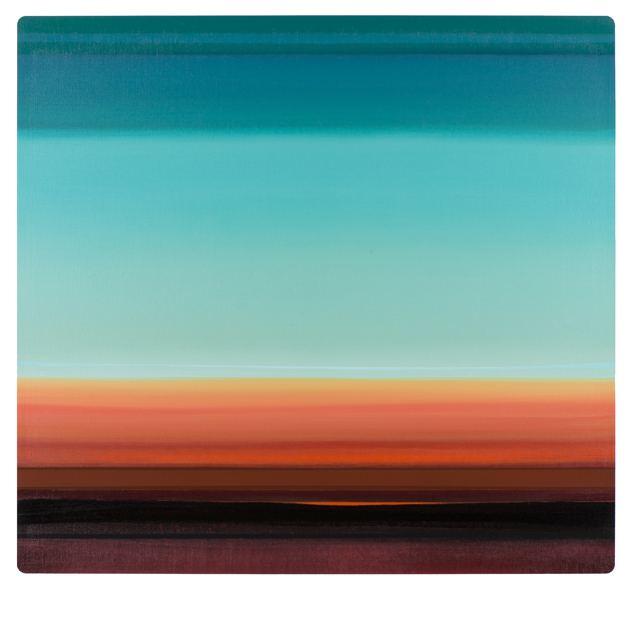
{Palm}
The artist recently invited Submerge into his airy studio to explain this latest collection of work and how an early experience at the Michael Himovitz Gallery on Del Paso Boulevard under the mentorship of then-gallery owner Chuck Miller led to the progression of his singular vision and ultimately into a successful career as an artist.
“I started interning there in ’98 or ’99, so toward [Michael Himovitz Gallery’s] later years. Michael had died already, but his partner Chuck Miller was running the gallery,” he explains. “I ended up mentoring under Chuck. He kind of took me under his wing, although he didn’t really care for my art, but over time he started selling my work and introduced me to designers like Paulette Trainor, you know, big figureheads in the community, so I was pretty fortunate. I was around that at a young age, which was great because I learned the gallery side before I learned how to be a career artist.”
And while the Himovitz gallery shuttered its doors in 2001 after a successful 20-year run, Miller and Crandall-Bear remained close, both personally and professionally, until the venerated mentor died in 2009. The lessons learned from that relationship still reverberate through Crandall-Bear’s experience as an artist—specifically one who still sees value in the gallery-artist collaboration, especially as many of his contemporaries look to other avenues for introducing their work to the world.
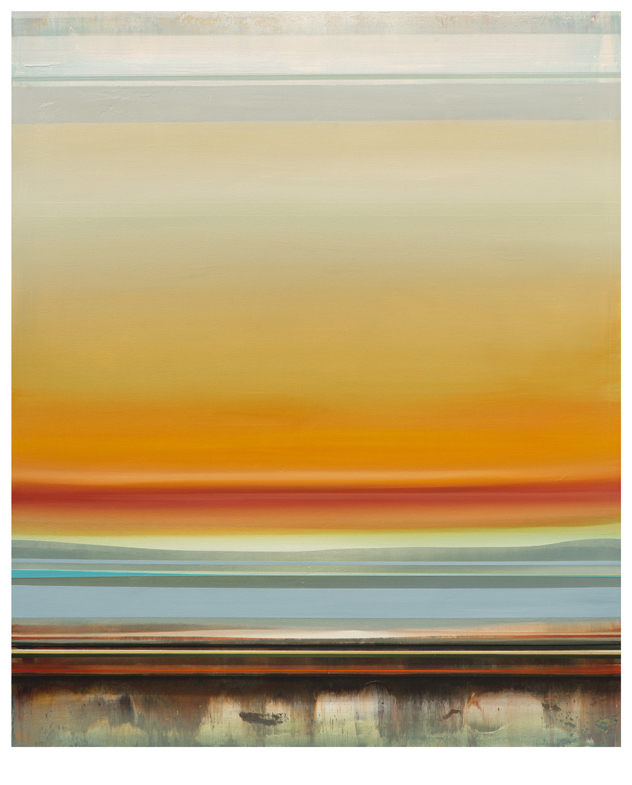
{Sublunar}
“Chuck and I continued to work together [doing] private art sales and design showcases. He basically just turned himself into a broker, an art dealer without the brick and mortar, but he sold art until he died,” he says. “So fast forward 10 to 15 years, there have been a lot of galleries that have come and gone, but the gallery world as far as representing artists is changing, especially with social media and Instagram. A lot of artists are using that platform, Instagram, as a sales platform, and they should: it works. There are a lot of artists in my community that don’t necessarily adhere to the gallery format like I do. As I said, I grew up doing that so it’s kind of what I always knew.”
Like most artists, Crandall-Bear’s work has been an exercise in evolution: from a series of figurative works with rigid urban tones, incorporating text, spray paint and elements of graffiti in the beginning, to the progression of a singular idea expressed through bold stripes and color fields.
Focusing on the work, Crandall-Bear’s art pieces have won him favor with art consultants, interior designers and corporations. And while his work adorns the walls of tech companies like Intel, skyscrapers in San Francisco, university hospitals, law firms, corporate and government offices and a slew of private residences, it’s the spirit of the local art community that has him really excited about Sacramento’s future as an emerging hub for creatives.
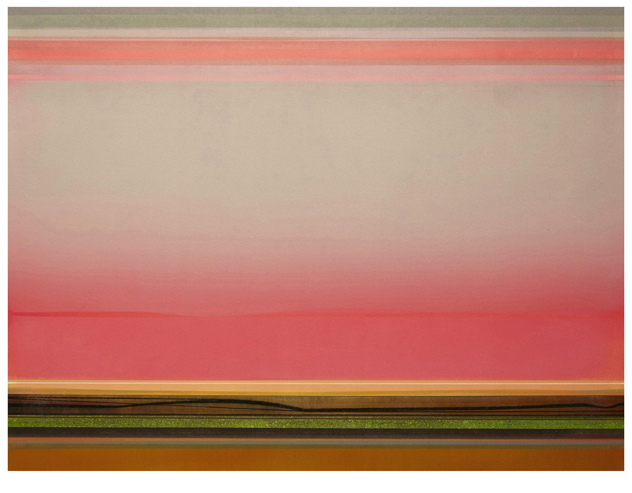
{Ultra Border}
“It’s an exciting community and I think right now it’s probably, as far as visual art, it’s the most exciting time in Sacramento’s history,” he gushes. “Right now there’s so much going on in the art scene with things like the [Bright] Underbelly [mural] project, WAL, Verge, Elliott’s gallery, and you want to be a part of that. You can liken it to other places, their story has been written, like San Francisco and L.A.; ours hasn’t and that’s exciting.”
As one of the artists whose work has contributed to the transformation of the historic 100-year-old Lawrence Warehouse into the Warehouse Artists Loft, a lofty experiment in a mixed-use, mixed-income community for artists located in downtown Sacramento’s Historic R Street District, Crandall-Bear has begun to embrace the idea of collaboration among artists.
“I feel like I, like a lot of artists, used to be in my bubble and work alone and just kind of be hyper-focused on my immediate goals. It was very linear, and now with it being an exciting time with visual art, there are so many other artists that are doing extremely well because of the community here,” he explains. “So I found myself really wanting to do projects where I’m collaborating with other artists and we’re doing these big paintings for like a music festival or something else. So I’ve collaborated with a few really amazing artists from more graffiti street-style artists to hyper-modern artist, [like] Jose [Di Gregorio]. We’ve done a big piece together and the community is growing. The spectrum of artists is broadening and therefore there are more artists becoming even more successful, which is good for all artists.”
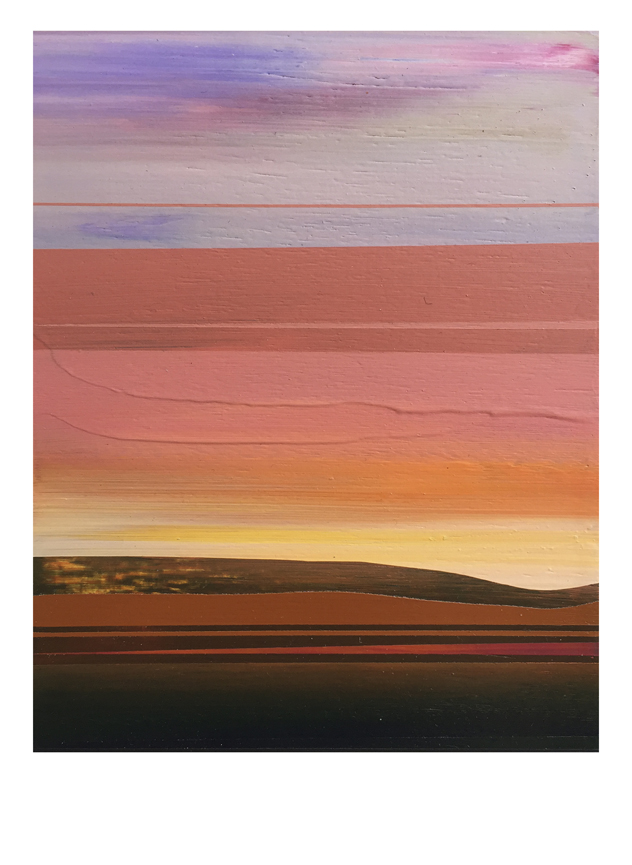
{Praxis 5}
As his creative point of view continues to develop in tandem with his artistic maturity and ambition, his latest show is pushing the Sacramento art community to recognize and embrace the beauty that can be found within abstraction.
“The work is meant to give a feeling of exhale to the viewer,” he explains. “We’re constantly surrounded by a world made of man-made things so [this show is about] when you get back to nature; it’s why I started painting like this. I paint what I like to see or feel, and so these vast colorscapes lend themselves to my life.”
His bold, nonfigurative compositions are imbued with explosions of color that are able to convey passion and excitement while, at the same time, evoking serenity and tranquility. And although this latest exhibition is instantly recognizable as a Crandall-Bear show, the artist says that he is taking his signature theme and breathing new life into the canvas.
“These pieces are still heavily layered and detailed, yet a sense of calm can be found as variations in dense tones give way to luminous neutrals,” he says.
Check out Latitudes which runs now through July 2, 2015, at Elliott Fouts Gallery, located at 1831 P Street in Sacramento. A reception for the show will be held on Saturday, June 13, from 6 to 9 p.m. For gallery hours, go to Efgallery.com. If you’d like to learn more about Micah Crandall-Bear and peruse his artwork before you go see it in person, go to Micahcrandallbear.com.
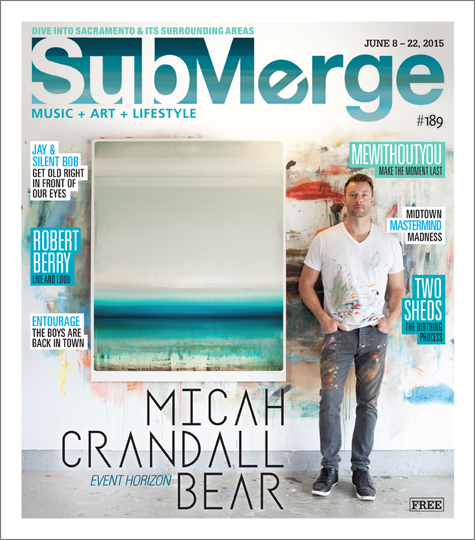
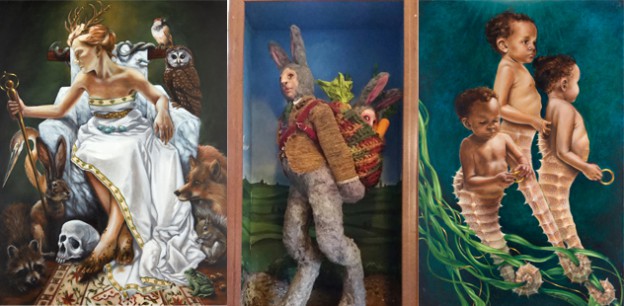
It’s a Whimsical Life
Artist Laurelin Gilmore showcases the beauty of everyday with unexpected imagery
Sacramento has always wanted to be a primary market, but as far as attendance at art and music gatherings go, has been a tertiary market at best. In the last decade, however, artists like painter/sculptor/illustrator Laurelin Gilmore have managed to eke out a living doing what they love most: working full-time on art. Not only is Gilmore an artist on the rise, she has won several awards and the approval of many fans and venues alike.
On any given day during the traditional Monday-through-Friday work week, you can find Gilmore holding court at Verge Center For The Arts (625 S Street, Sacramento), working on her craft. Because her rent is manageable, she is able to have a space away from her home in North Sacramento, where she currently resides with her husband and 8-year-old daughter who she says is “a better artist than I was at her age.”
“Being an artist is not a self-sufficient entity and my husband does need to work,” Gilmore recently said in a telephone interview. “However, it is my full-time job and I spend about five hours a day in the studio and have 24-hour access to come and go as I please. It’s great to have somewhere to go and create if I feel the desire late at night. On weekends, I usually spend my time with my family unless I have a show somewhere.”
For the uninitiated, Gilmore’s work is highly colorful, whether she’s doing drawings, paintings or three-dimensional sculptures.
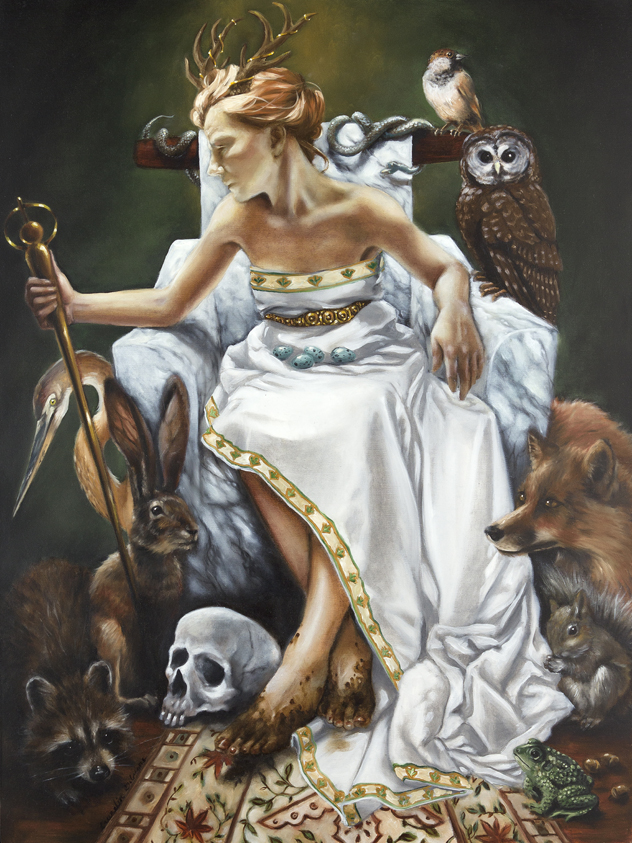
{The Queen Having Made Her Choice}
“I have been drawing as long as I could hold a crayon,” she says. “It’s really hard to quantify how many drawings or handmade pieces I’ve made over the years, but drawing was my first love. Up until 1998, I was strictly a pencil, graphite, chalk and charcoal artist.”
Gilmore says it was “just kind of a natural extension from hand drawings to expand and add texture and form” when she began painting.
“I’m still an advocate of drawing in its primitive and primary form, however.”
However, there is one medium that Gilmore doesn’t excel in. “I don’t do very well with colored pencil,” Lauren admits. “Using a colored pencil creates too fine of a line. If you cover a large area with colored pencil, you lose immediacy in the piece and it takes much more time. Rather than drawing a sky with colored pencils as a medium which can take hours, painting is far more expressive and, similarly, more colorful to view.”
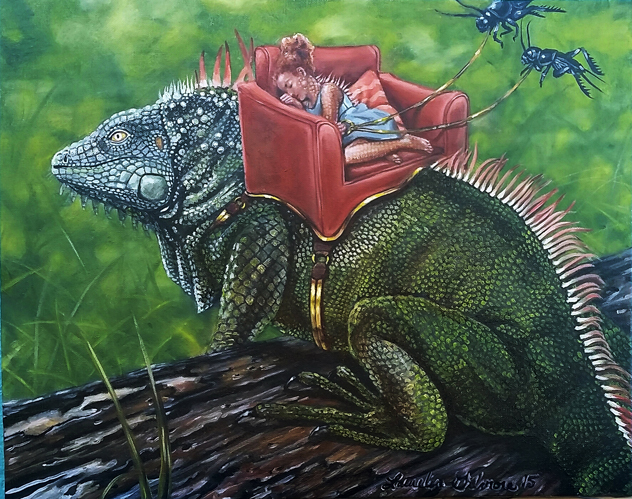
{Dragons}
In her artist’s statement, Gilmore says her subject matter “can be somewhat varied, but the human figure has always been my touchstone. My goal is to record on the paper or canvas as well I can the beauty of everyday through realism, surrealism and fantasy. My art looks at the place where separates meet, and explores through fantasy the experience of the would-be fence sitters as go-betweens, translators, and bridges between perspectives.”
Gilmore admits the collection she’s preparing for her show in September is one she’s “most excited about and terrified of creating.
“This is the most personal art I’ve ever made,” she says. “I am painting my experience as a person living with vitiligo…a skin condition that turns patches of skin white. I am using as models a couple of people who also have the condition and using myself as well to explore it as something beautiful and strange and strangely beautiful, I guess. Reactions span the spectrum, so I look forward to engaging viewers in a discussion on the topic that is motivated by seeing me and mine in a different light.”
Gilmore’s 20-plus-year tenure in the Sacramento Valley has garnered her fans, accolades and an appreciation for the Sacramento art community. She earned degrees in Fine Arts and Library Sciences from Sacramento City College and soon put down roots.
“Since I once lived in San Francisco, I always thought I could someday return there,” she says. “I have lived in Sacramento for over 20 years and it’s very affordable. In San Francisco or the Bay Area, there is a lot of competition in the artist community. Here in Sacramento, however, it feels much more like a tight-knit community.”
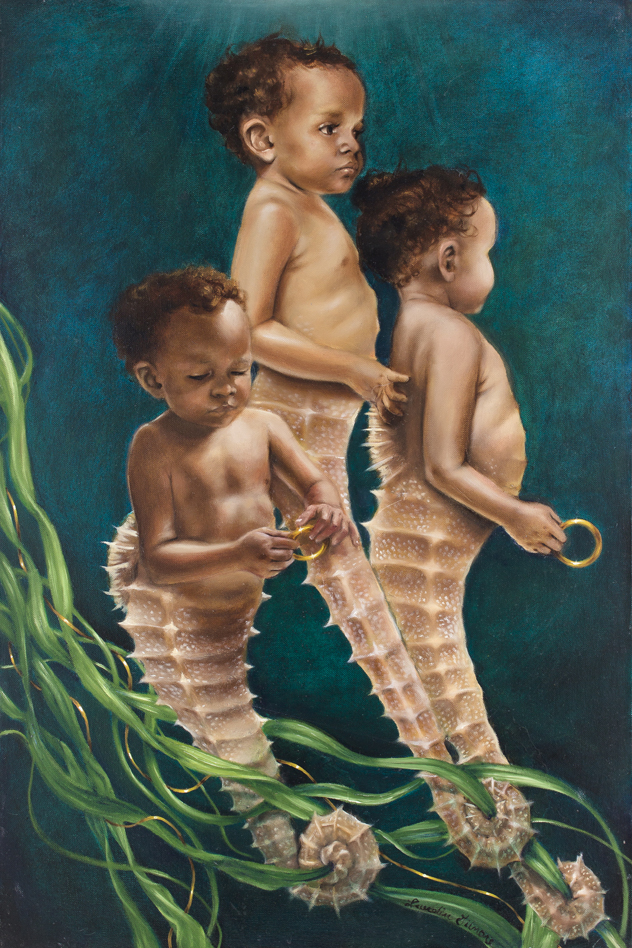
{Aquestrians}
Her tenure in that community begins with her very first sold drawing at a Sacramento City College art show (for which she still holds the $20 check “for posterity”), and continues with a stint at Gallery 2110 inside the Sacramento Art Complex, as well as entries in prominent shows. From 2012 to 2014, Gilmore had a studio space at Gallery 2110, where she earned commissions from several walk-ins. Though she loved the exposure, the downside was the 2nd Saturday traffic being able to see “things that were still in their creative womb,” she says. “I would often have a couple of easels up and people [would] see pieces in their infancy.”
Gilmore’s Self Portrait with Olivia drawing, of herself holding her infant daughter, was accepted to the 2007 California State Fair and sold. In 2013, Gilmore’s Coiled painting won Best in Show at the Sacramento Fine Art Center 2013 Animal House exhibit. “This is no small thing since there were some incredibly talented artists showing there,” she says.
Gilmore is looking to geographically spread her wings, and is on the hunt for more shows. But she’s calculatingly realistic about the prospects. “Last year I told myself I wanted to show in Los Angeles and New York and I did manage to get the former done,” she says. “I also want to do New Orleans and New Mexico. Basically, I’ve been looking for shows that I can drive to since you usually have to pay a fee to be curated, the gallery takes a percentage of any sales made, and it costs a lot to ship to out-of-town galleries. I decided I would only do shows that I could drive to unless there was something amazing like an international offer or something major that I couldn’t pass up.”
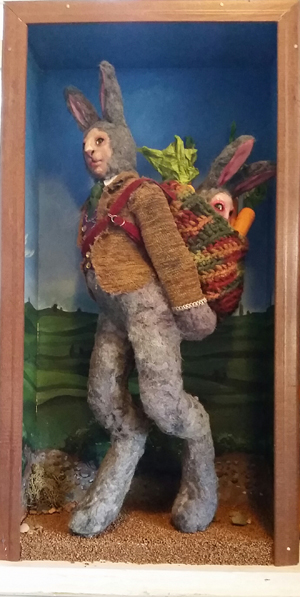
{From Market}
Making a living is a struggle when you’re a local artist, and for the most part, you either sell at one of your residencies or through constant word of mouth in the artist community. Gilmore, however, is optimistic about using cyberspace to boost her sales and maintain a semi-steady flow of income. She plans to open an online store connected to her website (Laurelingilmore.com) and branch out to other social media sites including Twitter.
“I’m not as active on the internet as I should be and stopped blogging a while back,” she says. “And while I do believe in artists telling their own experience, I just never really kept it up. Social media from my Facebook page has been a great way to get the word out, however, about shows and pieces I’ve done.”
For those who chose the uncertain path of being a full-time artist, it always helps to have a support system whether family, friends, or colleagues in her field. When pressed whether family has encouraged and acknowledged her chosen path as a legitimate one, Gilmore was quick to reply.
“It’s one of the questions many people ask me,” she says. “The fact remains that nobody ever told me to stop. My mother, husband, brother and two older sisters were always supportive of my endeavors and never questioned me. Additionally, I am still very close with the former owners of Gallery 2110 and they are great allies to have.”
Of course, no monetary value can take the place of human interaction and experiences. And while Gilmore has not become a millionaire overnight, it is her love for the art that has made a difference.
“Personally, I think my greatest triumphs have come from interacting with art lovers,” she says. “At the Sacramento Art Complex, I was so privileged to be able to meet and converse with so many people who had personal experiences relating to my art. There was a little boy who used to come in every single month with his mom and ask me questions about new work, old work, whatever. I really looked forward to seeing the two of them.
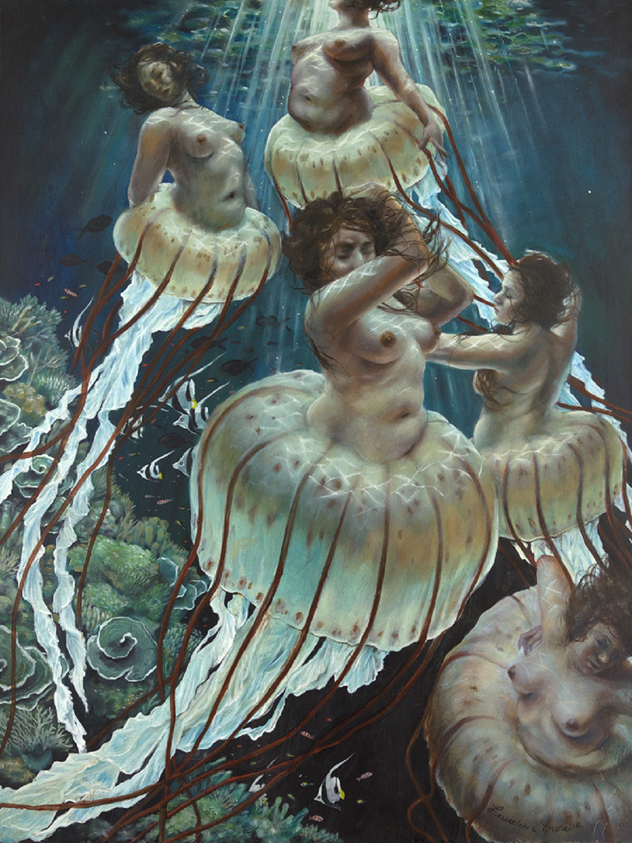
{Jelly Ballet}
“One woman told me that my painting, Jelly Ballet, has been used to inspire conversations about body image and body gratitude in her circle of friends. People told me they could see themselves, their loved ones in my work. I absolutely love hearing the stories people come up with around these creatures I’ve made. It means they inspire a thought process that goes in weird creative directions for people, and what else could I ask for?”
See for yourself at Gilmore’s upcoming show at Little Relics (908 21st Street, Sacramento), featuring shadow boxes and paintings. Opening reception is Thursday, April 9, from 6 p.m. to 8 p.m. For more info, visit Laurelingilmore.com
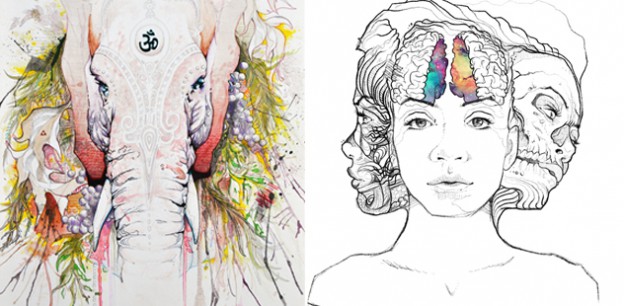
It’s All in the Details
Inside the Creative Mind of Sacramento Artist Daniel Choe
Artist Daniel Choe lives in what he describes as “a more colorful neurological hemisphere.”
His mind is constantly reaping the essence of overlooked beauty caught in the monotony of day to day life, only to let it seep in his brain and regurgitate it all via ink onto a blank canvas.
Choe creates pieces with the blackest calligraphy-like lines. You can see where he increases pressure on his utensil to create the marks that stain his canvas, spreading the ink darker and wider. The ink forms to create a topographic landscape with layers upon layers of varying depths that unite to make one entity, often splashed with a bit of watercolor.
He has described his work as being “An evolving culmination of matter that stems from my creative and illogical outbursts.”
You may have seen Daniel’s work wrapped around the silver coffee thermos from Temple Coffee, which is reportedly almost sold out because it was so dang pretty. I recently met up with Choe (pronounced Choy), to find out where he is, and where he plans to be.
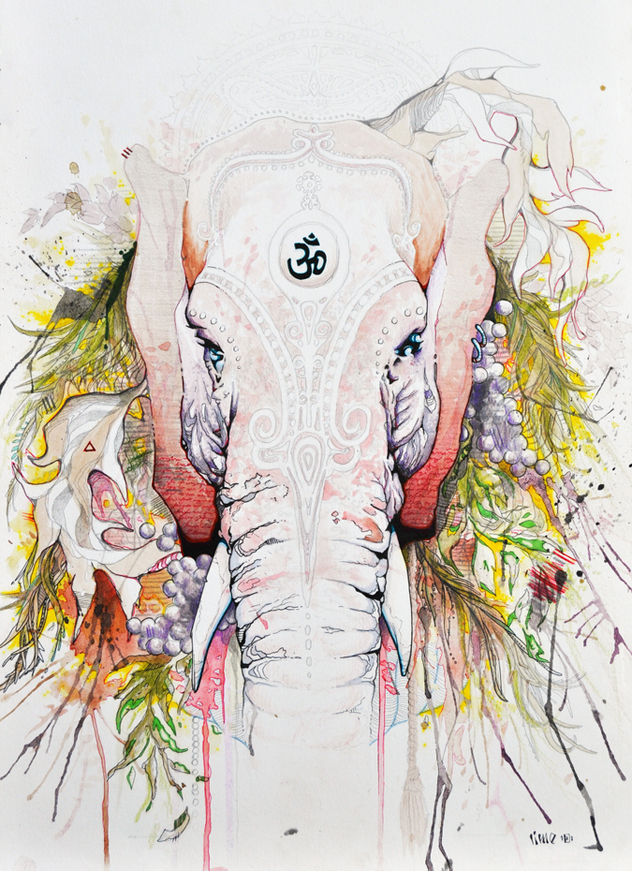
How has your show at Temple been?
It has been really good. I always work on art purely for self-gratification. Just to say my motivations with these things are usually me working on art because it feels good to me. Inquiries are never expected, but it has really been a pleasant after-effect of displaying my art in this show. I feel like I am being gifted with interests and opportunities right now.
You also designed a special thermos for Temple.
Yes, Temple asked me to help design a limited edition thermos for their artist series. I also manage one of the Temple locations, so I work closely with them on a daily basis. I chose to wrap a coffee plant around the thermos. It sold way better than I expected and was really successful. In fact, I think they are pretty much gone and sold out. Temple, however, has some more really cool things planned in terms of the thermos series.
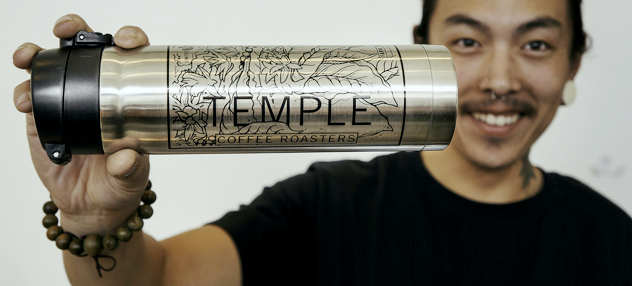
You also participated in the Pizza Rock pizza box design contest?
I created this really intricate and detailed box for Pizza Rock in a competition they held a little while ago. I utilized every section of the box from front to back, and even did a bit of research on the owners and took some of those findings and included little personal trademarks for each one. Only they would be able to find the trademarks among my designs.
Who are your subjects? You use a bunch of females. Are they friends or figments of your imagination?
Sometimes some of the subjects I know. Some are just inspired by passersby.
Most of the things I use are drawn from daily rituals and nature. I just look at physical life in-depth. I pay attention to things I see on my daily routine and I naturally incorporate it into whatever I am working on. For example, have you ever really picked up a leaf and examined it? They are everywhere, but have you picked one up every once in a while and noticed how beautiful and intricate they are? I like to take these little tidbits and appreciate them. One thing I really love to do is hike. Whenever I hike, I pay attention to texture and symmetry or lack thereof. I incorporate all of these things into my work.
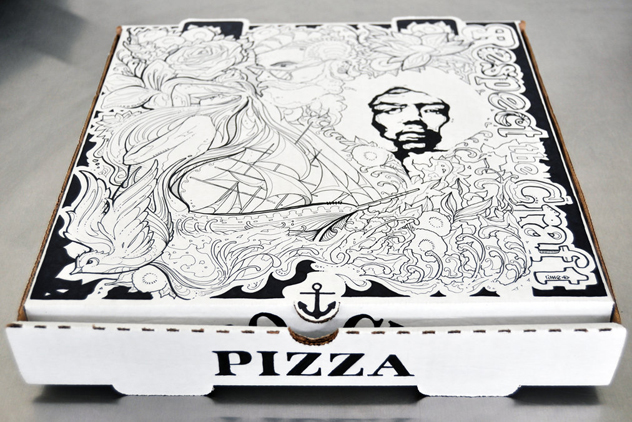
Is this why you like to use topographic lines?
My work has a lot of similarities to a topography map. Some people have even flirted with the idea of commissioning me to make an actual topographic map for them. I use the lines to show texture, contours and depth.
I recently read a book called Daily Rituals [by Mason Currey], and it explores the environments in which creative minds thrive. What sort of rituals do you have while working on your art?
I’m actually pretty neutral and low key. I sit in my small one bedroom apartment in Carmichael, usually with my dog curled up at my feet and some odd background noise. I like to curl up on my couch, or sprawl out on my kitchen floor. Usually a strange documentary for ambience will be playing in the background. I work almost 100 percent from home because everywhere else is full of distractions. A lot of the time, I just need to go home and spill out what has been mentally brewing.
Do you come from artistic roots?
My dad was a musician who drew on the side. At the time, I remember thinking he was really good. I mean, I still think he is really good, but it wasn’t his main artistic commitment. He was just a very creative person, and drawing was simply another avenue to express that. For me, it is my primary direction. The last few years, I have taken on a very serious relationship with it. Dad was a jazz percussionist who also played strings. I remember I would often bug my dad to draw me small things.
Despite this, I actually didn’t grow up in a household where art was commended. I’ll accomplish something, yet, I’m not a doctor or lawyer so its not good enough. I can honestly say that I’m pretty good at not letting things get to me. I do something I love and enjoy, that can never be taken from me. I never had a clear and supportive path paved for me. I work for everything I have, despite it being a struggle sometimes. I just chill and drink coffee and say, “Well, OK!”
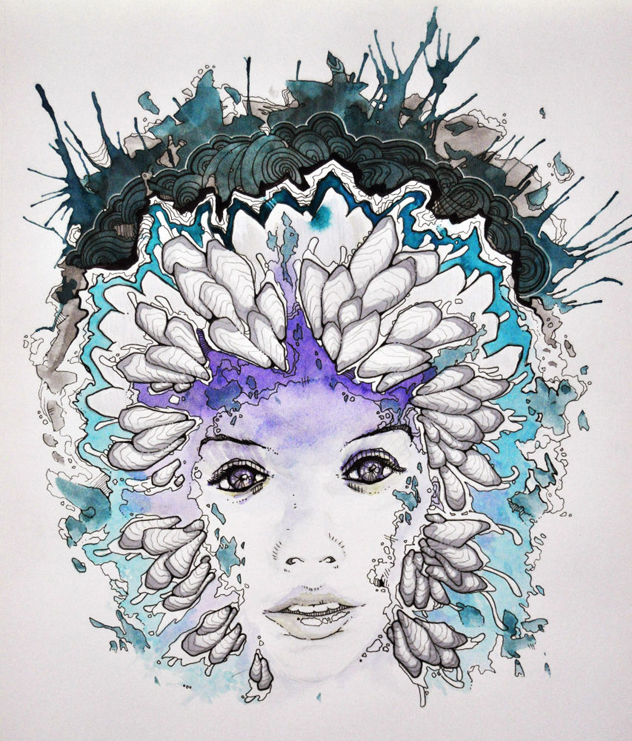
How do you handle critics?
Art is such a subjective thing. You’re going to get fans, and you are going to have critics who are not very happy with what you are producing. You kind of just have to roll with the punches. I’ve come to realize that I shouldn’t be trying to make anyone happy. Well, especially with me and art, because it has always been, like, this isn’t a job. I love this and it’s not turning into this thing I do to please others. If it upsets people, then that’s cool. It’s evoking some sort of emotion even if it’s not in my favor. Weighted opinions never really upset me, because it would limit me. It should leave people inspired to do something themselves and consider how they came to these feelings, and think back to initial contact with the piece.
On your personal site, Limeflavorednoms.com, you provide a list of intentions. What are some up-to-date intentions?
These intentions still all hold true. In essence, I just want to do everything. I think that Sacramento has an art scene that has so many great things going on. Every time I hear of a project, I want to be a part of it. I want to expand, collaborate and create as much as possible. I just want someone to offer me a mural to paint and I would be so happy.

Visit Choe’s site at Limeflavorednoms.com/press for upcoming show dates.
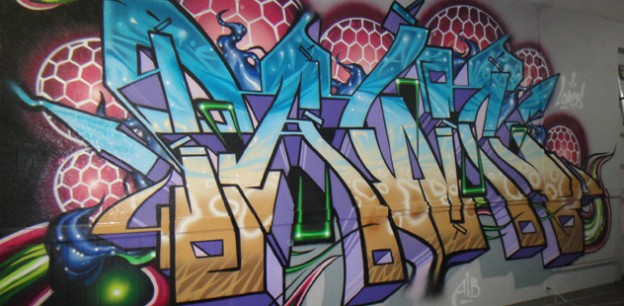
The Gleam and the Grime
Lord Pawn balances his graffiti writing roots with his current life as a professional artist
I must have been about 9 years old when I practically shat my pants from my first real world run-in with street graffiti, or at least what my young mind imagined street graffiti to be at the time.
My brother and I were walking home from school in our cozy Elk Grove-bordering neighborhood when we turned a corner and instantly saw five big distorted letters plastered on the adjacent fence next to us.
Dripping in what seemed like only hours-old red spray paint, the looming letters looked something like this:
To this day, I’m still not sure if that sloppily written message was saying Fuck U, or simply telling me to beware of FuckO, the newest graffiti boy on the block.
Frankly, it didn’t really matter; what I saw bothered me. Images of older, meaner kids roaming around my neighborhood with spray cans ran through my head as I pictured myself having to deal with one or all of them somewhere in the near future.
My childhood got a good gut check that day over what turned out to be nothing more than a one-time amateur tag job. What I witnessed was most likely done by a first-timer who might have just gotten a hold of his first can of spray paint and wanted to let loose on the nozzle for a thrill that, for some, only a canister of color and aerosol can offer.
Twenty-eight-year-old Sacramento graffiti artist Ryan Kroger, who officially paints under the name Lord Pawn, knows that feeling all too well.
Growing up all over Northern California and eventually settling in Sacramento, Pawn says he’s been painting for as long as he can remember.
“It’s something that I loved to do and I just figured it out on my own,” he says. “And honestly, I don’t paint the way you’re really supposed to because I don’t really follow the rules that I was taught in school… I feel like with art, you can kind of break the rules sometimes.”
Pawn says he remembers the days when he too was just a punk kid running around with a skateboard in one hand and a marker pen in the other. It wasn’t long, though, before he discovered spray paint and began writing his graffiti name on any surface he could get his can on.
As he grew older, Pawn ran with a few different graffiti crews in town, going where he wanted and tagging what he wanted. But it wasn’t until he got with Ain’t Life Beautiful (ALB) and, eventually, accepted into the world renowned Legends of Rare Designs (LORDS) that he started to slow down a bit.
“I feel like it’s something I did in the past, and sort of something everyone has to go through at one point,” he says. “So I mean, like, I do miss it, ‘cause there’s nothing more fun than running out on the freeway and bombing stuff. But, I guess I just can’t really do that anymore.”
It’s true. Not only is Pawn well beyond his juvenile years, but he is also a professional artist now—in spray paint and acrylics—with a reputation to maintain and commissions to lock down.
“At least in this town, I’m getting murals and stuff like that,” he says of his recent work flow. “And I don’t want to be someone the cops are after or anything.”
Pawn says he’s been fortunate enough to secure work consistently over the past few years, painting mostly character murals for companies like Red Bull, Technine, Tropicana, Sacramento Mustang and even the Sacramento Kings.
He also does residential and commercial murals for smaller businesses, like a close-up piece he did of a girl’s face for Dabstix—a smoke shop in Roseville—about a year-and-a-half ago.
Ironically, sometimes even graffiti abatement programs will hire him to spray paint over an entire wall in hopes of deterring other taggers from constantly ruining it. Apparently, the backwards strategy works.
“So they’ll pay for me to put a mural on [a wall], and the kids will respect it—they won’t go and tag it anymore,” Pawn says. “Then the business doesn’t have to pay to paint over it every week. So it’s like a good thing for everybody.”
As focused as Pawn has been on his successful painting career lately, he says he still gets the itch to the hit the streets every now and then when his days get to be a little too mundane.
“Sometimes it’s good to be in a grimy place,” he says. “I’ve seen some crazy stuff just going and painting… You get stories out of it all; you’re going on adventures.”
Pawn says some of the best graffiti is done under the radar, usually in the cuts of any given city. Even now, he doesn’t take issue with painting in these remote areas, so long as it’s out of the way and not hurting anyone.
“You’re sort of out where nobody else goes. You explore a little bit, find a spot you can paint and you don’t have to be clean necessarily,” he explains. “You can just go and do it. And then you leave something beautiful behind that’s pretty. And people have to find it for themselves.”
At this point in his life, Pawn has struck a good balance between grime and convention.
While he says he’s mainly interested in traveling the world to pursue a legitimate art profession from here on out, he’ll still find himself at rail yards at times painting massive concept projects on train cars with at least one other fellow writer—what he and other graffiti artists call themselves.
Pawn says he knows the consequences of painting over trains, which can become a federal offense if they go over state lines.
“If you get caught, you can get in a lot of trouble,” he says. “But I don’t know. It’s like, to me, it’s sort of something that I’m willing to risk because it’s not like… you’re not a real criminal. You know? You’re not stealing, you’re not hurting anyone. It’s artwork.”
Pawn’s personal time isn’t always spent out painting the town red, however. He’ll actually stay home pretty often to work on more detailed pieces that he eventually puts up for sale.
In fact, his very first art show was held this past Saturday, Nov. 8, at The Bench Art Supply and Gallery on 12th Street, where more than 20 original pieces—some acrylic, some spray paint—were on display and up for grabs to the public.
Prices went as low as $25 for prints to $5,000 for original works. His $5,000 piece—a 72-by-24-inch acrylic painting he spent a whole year working on—had already sold before the night’s end.
Pawn says he wants to do more art shows—not just for himself, but for the Sacramento art scene as a whole, which he thinks has potential to flourish.
“I think that there’s a lot to offer in Sacramento, but there’s just not that much of an art scene here, and there could be,” he says. “It’d be cool to start having some bigger artists coming through this city.”
Whether he stays in Sacramento to turn the art culture around or heads overseas to further his career, Pawn is sure to bring something new and exciting to the table in whatever scene he becomes a part of.
It’s funny how someone who produces such gigantic, surreal works of art can sport such a small name. But Pawn thinks it suits him.
“For me, it’s more of like a humble thing, you know? Because everybody wants to be a king, and really, we’re all just kind of like pawns—we’re the peasants,” he says. “There’s a saying that goes like, ‘The pawn is the most powerful chess player on the board,’ or something like that. Just because there’s many of you.”
Lord Pawn’s show at The Bench Art Supply and Gallery, located at 906 12th Street in Sacramento, runs now through Nov. 22, so if you haven’t gotten there to see it, we urge you to hurry it up! While you’re at it, follow Lord Porn on Instagram @PawnPaint. That’s what the cool kids are doing.

The Only Way Out is Through
After a lifetime in Sacramento, Matt Sertich is taking his solo act to L.A.
A healthy crowd gathers in Midtown for an early show in celebration of Matt Sertich’s first solo record, The Only Way Out is Through, a collection of stripped down, powerful pop songs that speak to love, pain, loss and all the other weird shit that creates the human experience. The vibe is mellow in Harlow’s, a room that can transform from an intimate singer-songwriter cave into a Latin dance extravaganza in the blink of an eye. The bartender is nowhere to be seen. Security guards stand leisurely, making jokes. Toward the back of the club, a table full of dedicated fans who have been following Sertich for decades, from his time in the pop-punk outfit Pocket Change to his 10-year stint in The Generals (with drummer/keyboardist/programmer Kirk Janowiak) to his present day solo career, let out a collective scream when the 37-year-old musician finally sits at the piano.
Sertich wastes no time. He breaks into “I Won’t Let You Down”—a strong, earnest ballad with an atmospheric background—and the room falls silent. His voice is loud and confident, with a thin string of pain that runs deep through his soaring melodies. Sertich is an interesting musician in that the songs he crafts are not exactly what count as popular today. In an era when singers either emulate rustic Americana or stare at the ground feigning disinterest in the world, Sertich chooses to face emotion head-on and write songs that celebrate life’s loftiest themes—pop-y ballads about love and hope. And what he creates comes from an almost childlike approach to music. “As a kid your dream is to write stuff like U2 or Whitney Houston … or what makes you feel so good inside,” he explains. “And as you get older you start getting into scenes and you start reverting backwards, kind of.”
After some soul searching, Sertich realized that he doesn’t have to cater to a scene or a trend. He’s going to make the kind of music that he wanted to make as a kid. And he does it well up there on that stage, singing like he’s trying to win back the girl of his dreams. The crowd, of course, is transfixed.
But Sertich hasn’t always had such good fortune with his music. In fact, much of what he’s faced is enough to make a weaker-willed musician smash his guitar, get a state job, crank out a litter of children and exit without so much as a whimper into the eternal bucket of KFC in the sky. But some of the stories he tells of his frustrating misfortunes are actually pretty funny. You know, once the heartbreak settles in.
For instance, there was a run-in with a Sacramento radio guy a few years back after he wrote “Keep the City Alive,” an ode to the the Sacramento Kings. Naturally, Sertich was excited about debuting his song on-air, but the radio guy played the song and immediately said it was horrible, that it sounded like Say Anything or Peter Gabriel. For Sertich, it was a confusing put down. After all, in his mind, a Peter Gabriel comparison isn’t quite the end of the world. But, still, it was a slight. And it was meant to be harsh.
Or there was one time he went to Los Angeles to be on the popular Heidi and Frank Show (95.5 KLOS). He was super excited about the appearance. That is until he arrived at the studio and found out he was booked for a “love it or hate it” episode, where the hosts would play your song and critique it (along with random callers) live on the air. They played The Generals’ “Just Because,” a fast-paced pop ballad about hope in the midst of darkness. The calls came in. One-after-another. Heidi hated it. Mike said it sounded like a Cure cover band. The song played through and Sertich sat through scathing, seemingly endless criticism. “It was so painful,” he says. “They were just ripping it.”
Anyway, Sertich somehow ended up garnering six votes, enough to sit for the rest of the show. Still, he was discouraged. But that situation—the uncomfortable, nearly unbearable awkwardness—made him stronger, more determined than ever to succeed.
“But I never want to play ‘Just Because’ again,” he admits. “I hate that song.”
Finally, after a weird run-in with The Jim Rose Circus Sideshow, where he was promised thousands of dollars to go on tour, which turned out to be a scam, The Generals decided to amicably call it quits, and Sertich decided to get his solo career off the ground. “I think with Kirk that was the last straw,” Sertich says. “It just depleted him.”
So, as The Generals winded down, Sertich worked as hard as he could on music in between his full-time job waiting tables at Tower Café. He practiced literally every day for a year—no matter how tired he was or how uninspired he felt—and came up with six tracks of piano-based ballads that became The Only Way Out is Through that he performs by himself with a synthesizer and drum machine. In the spirit of The Generals, Sertich’s solo songs are powerful, ’80s-tinged melodies that stand out, especially in 2014’s musical landscape of throwaway pop songs that rely more on tricky production than emotion.
“I grew up loving ballad singers,” Sertich says. “Like cheesy love songs that people make fun of.”
But oftentimes, people make fun of things that are memorable. And popular. Sertich’s obsession for ballads and his ear for powerful, larger-than-life arrangement results in a cinematic vibe, songs you might hear at the end of a movie where the protagonist screams triumphantly in the rain, even though all his friends are dead.
Since Sacramento might not be the best place for an artist like Sertich, he’s packing up his belongings, leaving Sacramento, the only home he’s known for the past 37 years, and taking his movie-ready songs down to Los Angeles, just to see what happens.
When I ask what he’s going to do down there, Sertich points to his CD. “There’s my business card,” he says. “There’s a lot of stuff going on out there. Just to reach out to as many avenues as I can when I’m out there, whether it’s playing as much as possible, networking, going to see a show.”
It’s not going to be an easy road. Sertich knows that. He’ll probably rent a room in Silver Lake, work as a parking valet and do his best to get his music into the hands of the right people. A scary prospect, but for someone who obsesses over melodies and arrangements, it makes perfect sense.
“I’m going to be full of fear because I’ve lived here all my life. There’s a lot of ups and downs. I get it, but it’s just going out there focused,” he says. “I’m not going out there because I’m trying to run away from anything, I’m going out there because I want to make it happen. It’s what I want to do. I don’t have a choice in the matter anymore.”
At Harlow’s, Sertich sits at the piano in the middle of the dark stage, red lights casting an eerie glow against his pale skin. He plays the song “In the End,” written as a letter from his father who passed away in 2005. It begins, “Son, I’m leaving now/ My time has come/ to say goodbye/ Son, I hope you know/ I’ve done the best/ that I could. I never meant to do you wrong/ Never meant to leave you there/ Leave you all alone.”
When Sertich sings, it’s not just the voice. It’s every atom in his body. In his muscles. His skin. Emotions stir in an aura that surrounds him, both joyful and dark. “And I only meant to be your friend,” he sings. “Hope you knew me better in … better in the end.”
Catch Matt Sertich on Thursday, July 10 from 11:30 a.m. to 1 p.m. during the Hot Lunch Concert Series at Fremont Park: 16th and Q Streets, across from Hot Italian. To buy The Only Way Out is Through, go to Mattsertich.bandcamp.com.
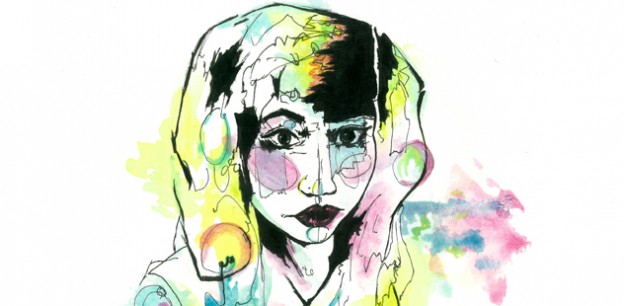
The Fairy Godmother and her Menagerie
Watercolorist & photographer Sarah Marie Hawkins develops nonprofit to support Sacramento artists
I have walked past the 2110 Gallery countless times, but sadly have never seen past the sculpture garden and central showroom (shame on me!). On a Thursday afternoon, I finally indulged in all the incredible gems this space holds. The gallery offers room after room of specialized artist territories—each acting as an almost too personal feeling—and a glimpse into the minds of each painter, photographer or director. At the very end of the hallway, an immaculately white room is adorned with blotches of watercolors, beautiful drips of pale colors and bold black lines. This is the mind of painter and photographer Sarah Marie Hawkins.
The artist completely fits her work: she is a splash of color to any blazingly white room. Her presence itself is a full representation of the color spectrum. And she’s using that charm to become a godmother of sorts to other fledgling Sacramento artists.
Just a few years ago, the 25-year-old was going to college in Santa Clara, studying to be a teacher and working an entry-level position at Google. Bogged down by the books, and deciding it really was killing her art mojo, Hawkins started dabbling in photography and focusing more on aesthetically creative endeavors. Soon after, she was a professional photographer.
“As soon as I knew it, I was in the same spot I was at before,” she says. “You hit a point where your art becomes your career. You’re left with no outlet.”
From there, she took it a step further and began working with a local nonprofit, where she had the opportunity to deeply connect with other artists as a curator. At this time she was solely a photographer. “An extremely beautiful yet expensive habit,” she says.
A mere two years ago, while constantly working around other inspiring painters, Sarah realized a passion for watercolors, and with quite a bit of trial and error behind the scenes, she honed her skills as an emerging painter. “I would stay up all night painting and completely lose track of time. It all just happened.”
Her work pays a lovely homage to femininity. Everything is light and whimsical, from the wisps of color in the featured woman’s hair, to the pale blue blotches of color that streams from her eyes. A personal favorite is a piece that shows two girls united by a balloon connecting their lifted ponytails, a piece that symbolizes the awesomeness of two friends being able to feel lifted in the presence of each other.
“I have tried to paint male figures, but in all honestly, they just didn’t do it for me,” she says. “The female figure is so intriguing. Men were just pieces of paper and paint to me.”
A constant in Sarah’s pieces is the use of branches. The branches usually grow wildly entangled out of a woman’s head, intertwining with her hair and existing beyond the woman herself. “A huge discovery was learning that you are never rooted to just one thing,” says Sarah. “A lot of these things represent the feeling of growth. There is continuity throughout them, especially the branch pieces.”
With this, Sarah somewhat outgrew the nonprofit she was working for, even denying a stable and well-paying job offer. She explains, “I felt like as an artist, I had this vision of what I wanted when it came to helping artists share their art. I was grateful for what I learned with the non-profit, but I also saw so many things I felt that I could do, and that I needed to do to help other artists.”
This is when Sarah Marie Hawkins started her new venture: become the fairy godmother to our town’s struggling artists with her very own nonprofit, Menagerie.
Menagerie will do a series of pop-up shows with dozens of different artist in different locations, or as Sarah puts it, “A circus of random things put together.”
Menagerie hopes to eliminate much of the business-type burdens that plague an artist while preparing for a show. “If you are taking $200 from 30 artists every month, where the heck is that money going? Stuff like that is what has always made me a bit uncomfortable in the art world, mostly because you often don’t see it actually benefiting the artist.”
Currently, Sarah is presenting the bill for the very first pop-up show for Menagerie on Wednesday, May 21, 2014 at District 30, ”a surprisingly awesome place to have an art show,” she says. “District 30 is super accommodating and very generous with their resources.” With this show, the artist pays no fee, and no commission is taken from a single thing the artist sells.
Essentially the pop-ups held by Menagerie will be a platform for artists to step up and support other artists. At the District 30 event, a photographer has even volunteered to do headshots of all artists for their portfolios for absolutely free.
“I know what it is like and how difficult it is to be a starving artist. But the cool thing about Sacramento is the unique relationship the art community has with each other.” Sarah elaborates. “I have seen a lot of the Bay Area art scene, and it is so cutthroat. It’s extremely competitive and everyone is against each other. Here, you have artists buying work from one another, and coming out to support others’ work. There is so much collaborating for a greater good in the art world. These are artists supporting artists here.”
The future goal for Menagerie is to eventually expand beyond pop-up shows and establish a gallery space and rotating work space for artists. “My hope is that we can somehow work to utilize someone’s extra space with each pop-up show. I hope that someone can visualize an unoccupied space’s potential and allow us to fill it with art. I seek people in my community to help me accomplish this.”
Fairy Godmother Sarah Marie Hawkins says she gets by in the art world with a little help from her friends.“ If I could generalize what all my pieces are about, it’s just about being consistent and being continuous. They are about never ever grounding yourself to one thing. Always seek what you love and grow with it. I definitely encourage anyone who admires something, to let yourself jump into it. Your art is never going to be somebody else’s art. I always look at other people’s art and think ‘wow, I could NEVER do that!” And I’m right because these pieces that I’ve done are solely me and I’m proud of that and the diversity of work that pours out of my community. Embrace what you have and strive to be yourself is what I’ve always tried to do, and art and the artists of Sacramento inspire me to do this every single day.”
Menagerie’s first pop-up show is May 21, 2014, at District 30. Doors open at 7 p.m., tickets are just $5. For more info, visit
Facebook.com/menageriesacramento.
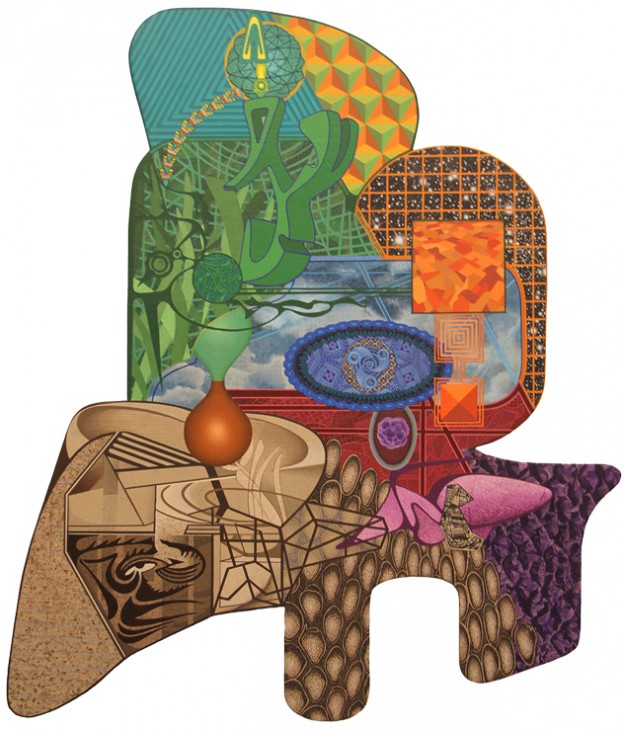
Art Exhibit Celebrating the Retirement of David Wetzl
From infancy to young adulthood, our brain is developing to understand the material world around us. As social creatures, a large part of this development is dependent on our relationships (nature vs. nurture, to put it simply). Arguably, some of the most valued relationships we will develop are with those most influential to us. If you don’t agree, why not ask David Wetzl’s art students. For two decades, Wetzl has been momentously impacting his students at Sacramento State and Sierra College. But after recently being diagnosed with frontotemporal dementia, a degenerative disease affecting the frontal and temporal lobes of the brain, Wetzl has decided to retire and dedicate his time to his personal works. Until March 1, JAYJAY Gallery (5520 Elvas Ave.) will be exhibiting Wetzl’s recent and classic works. Come see his beautiful response to this obstacle in life (for free), from Wednesday – Saturday, 11 a.m. to 4 p.m. For questions or specifications on exhibit show times, call JAYJAY Gallery at (916) 453-2999.
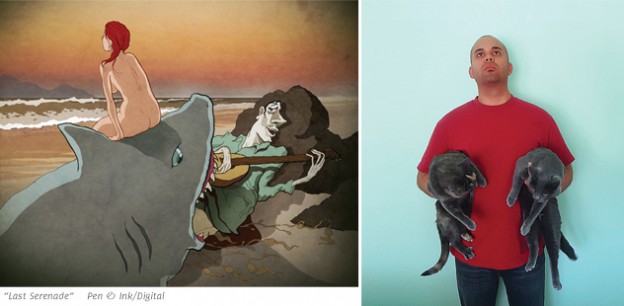
A Journey Into the Unknown
The bizarre worlds conjured by visual artist Erik Hosino
There’s something dichotomous about visual artists. Take for instance, art displays in coffee houses. The artist comes in and revisualizes the space, and patrons have the opportunity to scan each piece as closely as they’d like. But the artists themselves needn’t be present. On one hand, their work is upfront and exposed. But if the performance doesn’t need the performer, there lies some mystery. From the viewer’s perspective, it can seem as though the artist might feel isolated from new audiences, but it’s quite the opposite.
“It feels interactive to me and helps me get my artwork to such a wide array of people, just to see what they think of it,” said Erik Hosino, an artist nearly native to Sacramento who’s been displaying his work at Temple Coffee.
“One of the great things about hanging art at a place like a coffee shop, especially in a place like Midtown, is you really get a slice of the population. You get everybody from lawmakers, people at the capitol, to young hipster kids and everyone between,” Hosino said. “I’ve been flattered to see people who buy my artwork are not just this age group, this type of person, that I’ve actually sold artwork to young people, old people, white collared, all over. So in that sense I get that interaction.”
Hosino has been living in Sacramento since before he turned 1, and has been drawing throughout his entire life.
“The extent of my formal art training honestly doesn’t go too far beyond high school and a few classes at the junior college,” Hosino said. “I think the fact that I took to art at such a young age has kept me inspired to keep doing it.”
A huge part of that inspiration has come from studying well-known artists like Edward Gorey and his masterful pen-and-ink illustrations. Hosino’s work has been compared to Tim Burton’s numerous times, both sharing a similar darkness, also found in Gorey’s work.
“I’ve had people look at my artwork and think, ‘Are you depressed? Because you paint a lot of stuff about death and skeletons,’ but honestly it’s quite the opposite for me. I think that by sort of accepting death and celebrating it as a part of life has made it less taboo, and therefore it’s never felt weird to depict it whether in an explicit or more symbolic way. But because I am sort of drawn to the mysterious, I think that darkness and dark subject matter does lend itself well as fodder for my artwork.”
Since an artist is rarely present if you by chance see their work hanging somewhere like Temple, the next inevitable step a curious viewer would take would be to look up the artist online. If you search Erik Hosino, one of the first things you’ll come across is a website called Superheroes for Hire, or as Hosino puts it, “The thing I’ll look back on my death bed and kick myself for.”
The idea started out as a project for a class. In his late teens, Hosino had this idea for creating an agency of B-rated superheroes, banding together their lackluster talents to try to find work. The project was praised by his teacher, which inspired Hosino to develop the idea a little more. He sent the piece to Comedy Central and a few other networks. Comedy Central got back to Hosino and asked him to redraft the idea a bit. At the time, Hosino was about 20 years old, and with the motivation level of a 20-year-old and some unexplainable hesitation, he let the opportunity slide and never followed through.
“Now that I’m older and take my art more seriously in a lot of ways and am a lot more disciplined and passionate, I hate that I did that,” Hosino said.
While it was a heartbreaking setback, Hosino has kept the project alive in a smaller capacity. The website has an interactive feel to it, allowing the visitor to scroll through the various superheroes for background on their minimal capabilities, and a comment section for superhero service requests.
“It was a total lesson learned. I try not to beat myself up for it because I was young and I was straight-up stupid about it, but inspired me to keep the idea up,” Hosino said. “It only exists in that incarnation now, but in some ways it gives me some happiness to know it’s not totally dead.”
A good starting point to get a broad sense of his style would be checking out his collection called Strange Places, a book released in January 2011.
“I’ve had people come to me and say they want to buy either a print or original, and maybe they couldn’t afford the original or the one that they wanted was sold. Strange Places was partly a response to people’s desire to have a collection, just a sampling of my artwork,” Hosino said.
Hosino’s style is a blend of odd, imaginative and eerie. Bodies with bulky shoulders and torsos and pencil-thin arms and legs; dark scenery with curled tree branches or cavernous dark spaces. A mix of imaginative and morbid—all very slight, enough to set a somewhat creepy tone but not fearful. The book gives a good example of his versatility. Each style requires a different medium to create.
“If I want something chaotic or fluid, that’s where watercolor comes in; and if I want something really controlled, really tight pen and ink lines help achieve that,” Hosino said. “By day I’m a graphic designer, although I’ve been drawing a lot longer, the designer in me informs the way I work as an illustrator. It’s kind of a blessing and a curse. The illustrator in me often longs to be more spontaneous and organic, but the graphic designer in me longs for structure, planning and cleanliness and often times gets the better of me.”
It seems almost as a way to subconsciously merge both sides that Hosino gravitates most toward watercolor.
“I love the organic way, when I work with pen and ink and watercolor—which is a common combination for me—I’m very controlled with my pen work, and I let the watercolor play as much of a role as I do,” Hosino said. “I spent a long time trying to get a good command of watercolor, and it’s only recently I grew to accept it’ll kind of do its own thing. Not only did I accept it, I embraced the fact that I can control what I can control when I’m drawing, but when I put down that watercolor it adds a whole organic way to my illustration.”
Letting go of a little control has become one of Hosino’s main strengths within his artwork.
I’ve found those kinds of pieces that people gravitate mostly to of mine are the ones where they are interacting with it and filling in the blanks,” Hosino said. “That’s one thing people enjoy about my artwork and wasn’t intentional at first, but when I omit certain details to appease, people have come up and said, ‘Oh man I’ve been staring at this piece forever and trying to figure out what’s going on,’ and sometimes they fill in the blanks on their own, other times they like the fact that it remains unknown to them.”
See Hosino’s art for yourself at Temple Coffee’s downtown Sacramento location (1010 9th Street). It will be on display now through Dec. 12, 2013. Peruse the artist’s Web presence at Erikhosino.com.
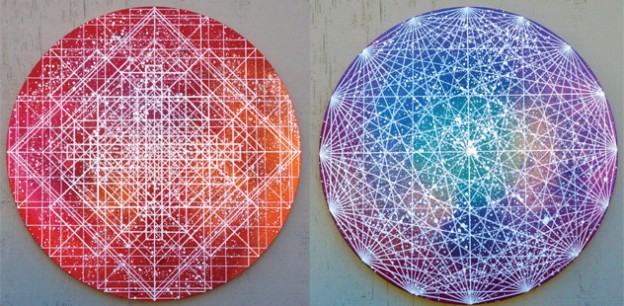
Into the Night
Jose Di Gregorio’s celestial shapes foretell Sacramento’s bright artistic future
In 2011, I walked into Bows and Arrows to browse some clothes and ingest either a coffee or a beer. I probably had some paperwork to do, but instead of doing anything that day, I just looked at a series of paintings exhibited on the wall. Those paintings—these large black backgrounds painted on wood with blue spray-paint accents that felt like something simultaneously underwater and atmospheric supported these large, brilliant white bodies or figures that were grounded between a few rudimentary geometric patterns and curling, waving tails that loped toward the bottom of the work—those paintings were composed by Jose Di Gregorio.
Now, I don’t know much about art, but occasionally I read some people who do. From what I can gather, the only thing a good artwork should do is negate reality in some fashion. This is not to mistake the desire of artworks to be considered realistic, or to be part of the material world that we exist in, but rather that they should act as mediators.
All of that is to say, in general, art that seeks to represent in a mimetic or realist fashion bores me. Our conditions today are so much more complicated and full of possibility than some bowl of fruit or a landscape. When I first came across Di Gregorio’s work, this is what it was clearly critiquing. This, for me, was its appeal. And I can only think of about two other Sacramento artists that I have remembered in similar fashion—but I’m not writing about them here.
Di Gregorio’s works are cosmic. They chose as their subject the infinite possibilities of our universe, and they hypothesize that these coordinates and celestial bodies might offer one of two things: either hope, of the sort that only post-apocalyptic genres can allude to, or humility, of the sort that alien encounter narratives tend to provide. Maybe they do both. What’s great about Di Gregorio’s works is that they are also questions in themselves, riddles of sorts. They offer each viewer her own Rorschach test, a reflection of her inner beliefs and ideologies. They suggest that each viewer can be validated externally, and because of this, Di Gregorio has patrons from physics professors to fanatics of the everyday divine.
His new show, Night, will be displayed at Bows and Arrows, some two years after his previous exhibit. It’s a shift from his larger works previously available at Bows, and at the Indianapolis Museum of Contemporary Art, where he just had an installation. In an effort to make his works more obtainable for enthusiasts, the sizes have been decreased, but the attention to detail is evident. The cosmic influence is still apparent, but these works are essentially circles or mandalas—a term Di Gregorio uses himself, though he’s quick to separate it from any spiritual association. Each of these mandalas holds a geometric figure, some series of white lines on a nebulous background composed by specific measurements within the frame, and they offer a continuation of the thoughts I was first attracted to in his earlier work.
“There’s some sort of meditative quality to them,” says Di Gregorio. “And I’m not a spiritual guy at all.”
Each of these pieces has a different geometric rhythm, a different figure or shape that holds the frame together. The white lines are crafted, composed with detail and attention. Their initial appearance seems simple, yet the specific shapes and lines reveal a concentration, a repetitious series of paint and articulation. It is because of these recursive structures, shapes, figures and the cosmic image set, that the spiritual qualities are easy to identify.
“The spiritual nature of these pieces comes up a lot,” says Di Gregorio. “I used to be a pretty outspoken atheist. [Yet,] I feel like these works are my ways of seeing the spiritual.” This seeing the spiritual, I’d associate with the sort of focus that artists must possess, not only to create works, but to continue to create them in our chaotic, distracting contemporary. It’s a sort of satisfaction that I’ve often thought of as addiction.
One could say Di Gregorio is addicted to simple figures and infinite depth. “There’s something about drawing a white line on a black surface,” he says, and then pauses to consider it further. It’s clear at this moment that his craft has a visceral effect on Di Gregorio, that the reason he pursues art has something to do with the metaphysical experience of drawing a line. This inversion of black and white, the associations of figure and background, is part of how Di Gregorio turns the subject of his works on its head. He never finishes this thought during our time together, to tell me what that “something” is.
Instead, I might offer that space is infinite, dark, unclear. An artwork is fixed, illuminated, specific. Traditionally the canvas is light, the marks dark. An opaque background asks for figures that register as shadows, bodies, inversions of light. A pitch dark background asks for figures that register as bodies of light themselves. This is part of that negation I mentioned above. However, it’s likely not how Di Gregorio would describe his work: “I don’t have a deep philosophical notion of what I do. It’s celestial, of course.”
“When I was an undergrad,” Di Gregorio continues, “I was researching the works of Caspar David Friedrich. He was a romantic painter during the Enlightenment. He was sort of countering the Enlightenment philosophy with the idea of the sublime, how small we are. That idea of the whole.”
This influence is clear once one sees the vast landscapes and seascapes of Friedrich, the horizons that loom over the lower third of the works, the immense skies with all of their impossibilities dominating the space of the canvas. Change the subject to space, swap out the human bodies for geometric figures, add a touch of improvisation and post-expressionist impulse: this is Di Gregorio.
The subject of his works is complicated, but his continual return marks Di Gregorio’s works with a specific focus. As he explains, “Maybe I’m just fascinated with something that is hard to explain. The feeling of being overwhelmed. We want to describe it, and maybe I’m describing it visually.”
That feeling of being overwhelmed isn’t lost on the community of Sacramento. Di Gregorio recalls the recent Capital Artists’ Studio Tour at Verge Center for the Arts, where many local art enthusiasts would peek into his workroom, glance at the untraditional works, and quickly slide back out the door. He laughs, recalling a question one patron asked another Verge staff member: “Do the artists here show their works anywhere?” These well meaning sponsors of the arts, I might offer, are overwhelmed by Di Gregorio’s works as well—just in a slightly different way.
This incident stands out for Di Gregorio, having just completed an exhibition at the Indianapolis Museum of Contemporary Art. This might be the highlight of his artistic career. “It was the best show I’ve ever had,” he says. “It was all flat black, the walls, the ceiling, everything. We used red and blue light, and the works really popped. It was like a heavy-metal planetarium. I had just gone to the Lawrence Hall of Science Planetarium [in Berkeley] with my daughters. It was such a profound experience; I just wanted to mimic that. I got a budget. They flew me out. I did a mural. It was great.”
“I wish I could be an installation artist all the time,” he adds. “That is it. I got that taste.”
To go along with his recent accomplishments, Di Gregorio has recently shown at Sol Collective, designed a limited edition bottle for Ruhstaller Beer, designed and crafted a huge artwork for the recent Launch Music Festival in collaboration with others, and provided some aesthetic touches to the McKinley Park playground rebuild.
“That was over 100 hours in just one week,” elaborates Di Gregorio, “14-hour days, leaving at 6:30 AM and getting home at 9:30. Most of the work was in the mosaic, and I’m not a mosaic artist. I created this lunar/solar mosaic, and another one in the entryway. That took a lot of time, cutting the tiles and getting the right colors. People who go there always notice the lionfish. Actually, the climbing wall and the lionfish were an afterthought. It’s funny how things work. I live in the area, so it’s a humbling thing.”
Having grown up in Woodland, Jose Di Gregorio is excited to be included in the community of Sacramento. He sees a lot of possibility here: “I think that there’s going to be positive change in what happens in Sacramento art. I want to think we’re getting beyond a sculpture of a bowl, or a cowboy, like Old Sac stuff, the Wild West.”
With works from artists like Di Gregorio, here’s hoping that we might soon be recognized as stellar or even universal.
Night, an exhibition of new work by Jose Di Gregorio and Jared Tharp, will be on display at Bows and Arrows in Sacramento Oct. 4 through Oct. 31, 2013. An opening reception will take place on Oct. 4 from 6 to 9 p.m. For more info, visit Bowscollective.com.


